“I think you’re forgetting something. If there’s one thing I can do is talk.” Christopher Eccleston as Doctor Who
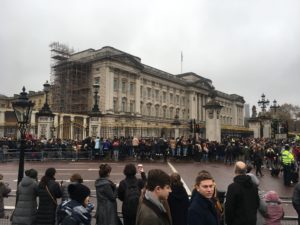
Last post I wrote at length about how much I adore visiting St. Paul’s Cathedral. I consistently rate the experience of visiting the marvel five out of five stars. Buckingham Palace, on the other hand, isn’t as special an experience. I still recommend going for a visit, especially on a Sunday when traffic to the Mall (the street that runs west to east from the palace all the way to Trafalgar Square, St. James’s Park bordering the Mall on the south) is closed, so pedestrians can enjoy views of the palace and the nearby Victoria Monument without all the hustle and bustle of cars and busses circling about. That said, I don’t think I’ll go out of my way to see Buckingham Palace on future visits, especially now that I’ve also witnessed the Changing of the Guard. (I never got to see the ceremony during my first two visits to London.)
The Changing of the Guard is, well, fine. It’s exactly as you’d expect, I suppose. The new guard gets ready at Wellington Barracks by St. James’s Park; the old guard stationed at St. James’s Palace will leave the palace in formation and march down the Mall towards Buckingham Palace while the old guard at Buckingham Palace will line up and wait at the nearby gates; the new guard will then march in formation from the barracks to Buckingham Palace; then both old and new will present arms and exchange keys; once everyone’s inspected and counted, the old guard goes to the barracks and the new guard goes to their stations at the two palaces; and through most of this, the band plays a selection of tunes to entertain the hoards viewing all this ridiculous pageantry, tunes ranging from patriotic to popular. (I believe they played ABBA at one point).
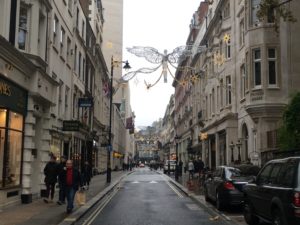
So, it’s fine. Go if you want. (Or don’t.) Whatever you do is fine. I honestly don’t care what you do. If navigating a packed crowd (everyone’s mouths agape, children asking ridiculous questions when the answer is right in front of their eyes) and standing on tip-toes to (maybe) catch a glimpse of the proceedings sounds interesting to you (try to be at least six feet tall, if you can) then by all means go ahead. Have a blast.
After Buckingham Palace, we made our way east on the Mall and then north through various streets (discovering St. James’s Palace on accident, a red brick Tudor building built during the reign of Henry VIII) to visit and explore the Soho area of the City of Westminster in the West End, a major entertainment hub for theatres, restaurants, pubs, and shops. It was really quite lovely to get out of the more touristy zones for a change in favor of neighborhoods like Soho. It was also really quite lovely to just walk around to see what we might discover, no real plan in hand.
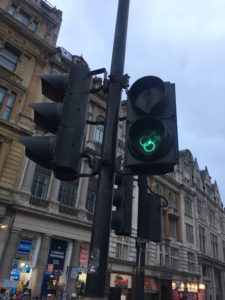
As it was lunchtime, we elected to try out a place called the Blue Posts, but not before stopping at a Caffe Nero on the way, a coffee and tea chain this side of the Atlantic that actually makes quite good coffee and tea (which I generally don’t expect from chains). Blue Posts, on the other hand, is a “traditional corner pub with basic menu,” as Google describes it, and that’s basically what it was. Amy, Aaron, and I decided to have a traditional Sunday roast that came with roast beef, roasted potatoes and carrots, Yorkshire pudding, gravy, cheesy cauliflower, and something else, I think. It was actually somewhat unmemorable and clearly didn’t leave a lasting impression. (The Sunday roast I had outside Oxford at a pub called the Bear and Ragged Staff on our first day in England was far, far better.)
Following our mediocre Sunday roast, we decided to make our way on foot to the London County Hall to enjoy an afternoon production of Agatha Christie’s Witness for the Prosecution, stopping by Trafalgar Square (where we noticed a pedestrian crosswalk signal that used the “double male” symbol signifying gay men rather than the more usual “walking man” symbol), the Women of World War II monument on Whitehall (a rather tall, ominous, austere, black monument depicting the various roles women had during the war), and, naturally (because it’s hard to miss) Elizabeth Tower and Westminster Bridge.
As Witness is performed at County Hall, it is conveniently staged in a real courtroom within the hall, which was once the headquarters for the local London government but is now occupied by businesses and (probably boring) attractions like Sea Life London Aquarium and London Dungeon. The whole structure is a large six-storey building designed in an Edwardian Baroque style, a stately crescent in the middle flanked by two rectangular wings on each side.
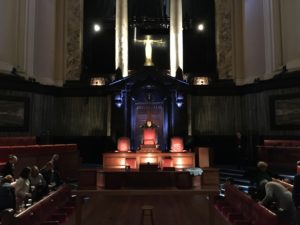
Originally a short story written by Christie in 1925 and then adapted by her into a play and premiered at the Winter Garden Theatre in 1953, this current production of Witness for the Prosecution was simply astonishing and gripping, superb and transcendent, an absolute marvel, a real gem, an incredible performance! Really, truly, deeply, a must-see event! The cast features such powerhouses as Jeffrey Kissoon as Mr. Justice Wainwright, Jane Lambert as Janet MacKenzie, Kevin McMonagle as Mr. Myers QC, Owen Oakeshott as Inspector Hearne, and Crispin Redman as Mr. Mayhew, but also relative newcomers making their West End debut: Taz Skylar as Leonard Vole, Amelia Annowska as the Woman, Craig Talbot as the Detective/Policeman, and George Howard as the Clerk of the Court. But despite different levels of experience, the entire case was rock solid (a testament to the work of director Lucy Bailey), each and every one of them delivering riveting, captivating, engrossing performances. And everything else was equally superb and magnificent: the lighting by Chris Davey, the sound by Mic Pool, the set design by William Dudley. And to everyone else I left out in interest of space: bravo, bravo, bravo!
But lastly, we have much to be thankful for in Christie’s writing. I had read the short story ahead of attending this show, and I had also read about how she had changed the ending for the play. (I won’t spoil it for you.) But it is all really quite ingenious the tale she weaves of multiple characters’ perceptions of the murder that was committed, the lies and truths that were told, the memories of individuals that flit between fickle and reliable. It’s really quite remarkable. Her ability as a writer is simply astonishing: to persuade readers that any one of the disparate stories told could be the truth, that any one of the characters’ beliefs in what is true could be the correct belief.
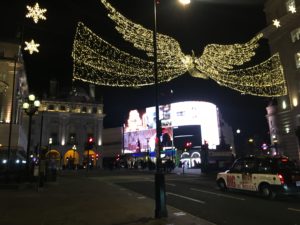
I could keep gushing and gushing about how much I loved this production! Simply spectacular! Definitely the greatest performance I’ve seen of any show in quite some time! Just go see it! You must!
Anyway, onwards. As Witness was a 3:00 show, we had plenty of time for post show ales at a lovely little pub dating from the 18th century, tucked away on Rose Street in Covent Garden, called the Lamb and Flag. Over ales, we realized we hadn’t yet had any proper Indian food on our adventures, so we made 8:00 reservations at a place called Farzi Cafe. There, we enjoyed salmon tikka, braised lamb shank (“nihari”), and wagyu beef boti kebab with, naturally, an assortment of cocktails. Both places were quite lovely, and both places provided an excellent way to end such a fantastic afternoon of theatre.
Our evening then came to a close, but not before we enjoyed some nighttime views of Christmas displays near Picadilly Circus on our way home to South Kensington. The next day, we continued to have more adventures in London, but it was on this day that we learned that even the British can (patron me) fuck up a Charles Dickens classic.
